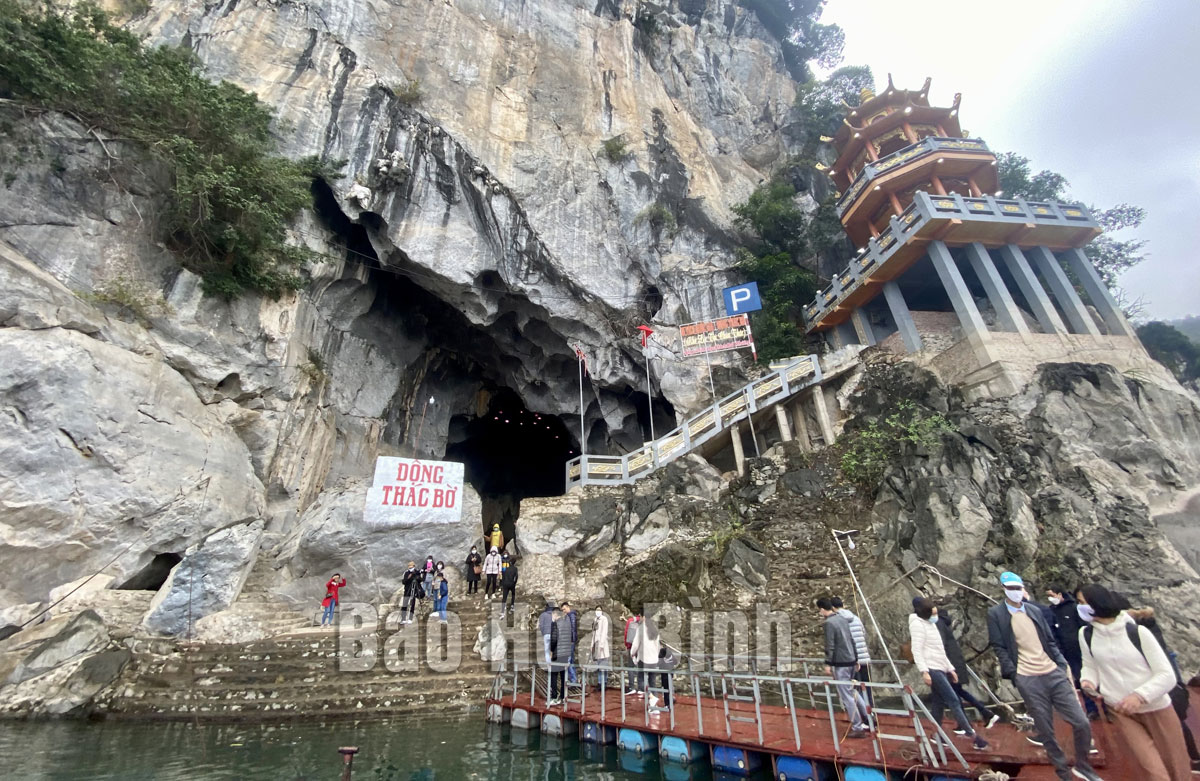
(HBO) - Thac Bo Cave is not only an attractive site of spiritual tourism in the festive season but also a renowned destination in tours of the Da River reservoir.

Thac Bo Cave in Suoi Hoa commune (Tan Lac district) is an
attractive destination for both Buddhist pilgrims and tourists.
Located in Bung hamlet, Suoi Hoa commune, Tan
Lac district, Thac Bo allows tourists to let their imagination run wild among
stalactites and stalagmites.
During the dry season, visitors must climb
nearly 100 stone stairs from the foot of the mountain to enter the cave. During
the flood season, boats carry visitors straight to a floating bamboo dock that
runs roughly 50 metres to the cave entrance. From the entrance, tourists can
look over the Da River, mountains and forests.
Dinh Son Tung, head of the district’s Culture
and Sports Bureau, said locating 100m deep in the mountain, the unique cave was
formed tens of thousands of years ago and divided into three areas, with the
first resembling a big living room. Thac Bo Cave holds a wonderful sight with
stalactites of all sizes and shapes – some look like carps, others look like a
tree, an umbrella, or a gong of the Muong ethnic group.
Many have even dubbed the cave as a giant
lithophone with its sounds created by mineral-rich water seeping down to the
stalactites.
The stalactites also pile up to form an altar
measuring about 50m high where people worship the Buddha. Stone pillars
naturally growing in the cave look like statues of the Buddha.
Visitors to Thac Bo pray for good luck, good
health and peace and explore the natural scenes.
There is a long list of nearby attractions that
visitors can add to their trip, such as the Ba Chua Thac Bo Temple, Trach
stream, Ngoi Hoa Cave and local ethnic villages like Ngoi and Muong Giang Mo.
Visitors should also take the chance to explore
special culture and delicacies of the Muong group./.
A diverse chain of eco-tourism and resort destinations concentrated in Hoa Binh city and the districts of Tan Lac, Da Bac, and Luong Son… Along with the launch of several key high-quality resort tourism projects, these developments have reshaped the landscape and enhanced the appeal of Hoa Binh as a travel destination.
Boasting diverse terrain, a mild climate, and rich natural resources, Cao Phong district is increasingly asserting its place on Vietnam’s tourism map, attracting both domestic and foreign visitors. The district is renowned for its stunning landscapes, majestic mountains, a crystal-clear hydropower lake, and the unique cultural identity of local ethnic groups.
With its pristine landscapes, unique cultural heritage of Muong ethnic minority, and an expanding range of visitor experiences, Tan Lac district of Hoa Binh has fast become a captivating destination for both domestic and international tourists.
Until now, Sung village in Cao Son commune, Da Bac district remains the only Dao ethnic community in Hoa Binh province to develop a community-based tourism model. Beyond its untouched natural landscapes, cultural identity serves as the cornerstone attraction for visitors.
Alongside the diverse cultural identities of the Kinh, Muong, Tay, Thai, Dao, and Mong ethnic people, Hoa Binh province is also renowned as the "capital" of the northwestern Vietnamese cuisine, offering unique and distinctive dishes. At festivals, during Lunar New Year (Tet), or on significant family or community occasions, special dishes are prepared, leaving a lasting impression on visitors.
A Phong Linh (Yellow Tabebuia) flower garden in Thang village, Thach Yen commune, Cao Phong district is currently in full bloom, drawing a large number of visitors.



